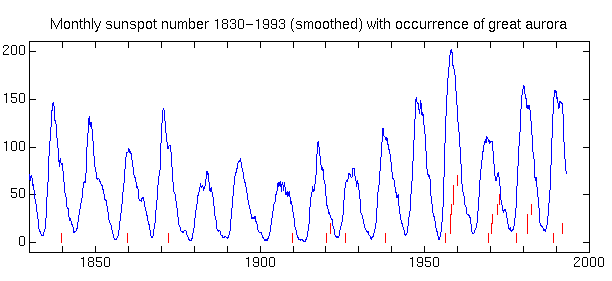 Great aurora
Great aurora Great aurora
Great auroraGreat magnetic storm are often related with auroras of high visual brightness that are seen at exceptionally low latitudes. Especially, two types of high altitude red auroras are seen:
| Date A.D. | Seen in |
|---|---|
| 37 | Rome |
| Oct 5, 1591 | Nuremberg |
| Feb 10, 1681 | Pressberg, Hungary |
| Mar 17, 1716 | Europe |
| Sept 15, 1839 | London |
| Aug 28, 1859 | N. America, Jamaica, Rome |
| Sept 2, 1859 | N. America, S. Salvador, Athens |
| Feb 4, 1872 | Bombay, Mexico, Athens (zenith) |
| Sept 25, 1909 | Singapore |
| Mar 22-23, 1920 | Oslo, Washington |
| May 14-15, 1921 | Samoa (13S), Jamaica |
| Jan 26, 1926 | Scandinavia |
| Jan 25-26, 1938 | Oslo, Azores, N. Africa |
Of these, the ones in 1859 were very important as they resulted in papers about such novel findings as solar flares and geomagnetic pulsations. In addition, here are some more recent events (same source):
| Date A.D. | Notes |
|---|---|
| Feb 24-25, 1956 | Alaska |
| Sept 13, 1957 | Mexico |
| Sept 22, 1957 | Mexico |
| Feb 10-11, 1958 | N. America, Mexico, USSR |
| Sept 3-4, 1958 | Canada |
| Sept 4-5, 1958 | Canada |
| Nov 27, 1959 | |
| Mar 23-24, 1969 | |
| Mar 8, 1970 | |
| Aug 17, 1970 | Rocket obs. |
| Dec 17-18, 1971 | |
| Aug 4, 1972 | ISIS-II, SAR arc |
| Dec 1-2, 1977 | Morning-dayside |
| Mar 5, 1981 | Thermal, Boulder |
| Apr 13, 1981 | Arizona |
| July 13-14, 1982 | Major storm |
| Mar 13, 1989 | Great aurora |
| Nov 8-9, 1991 | Great aurora (McEwen and Huang, 1995) |
Note how the sunspot cycle is reflected in the occurrence of great aurora:

See also: